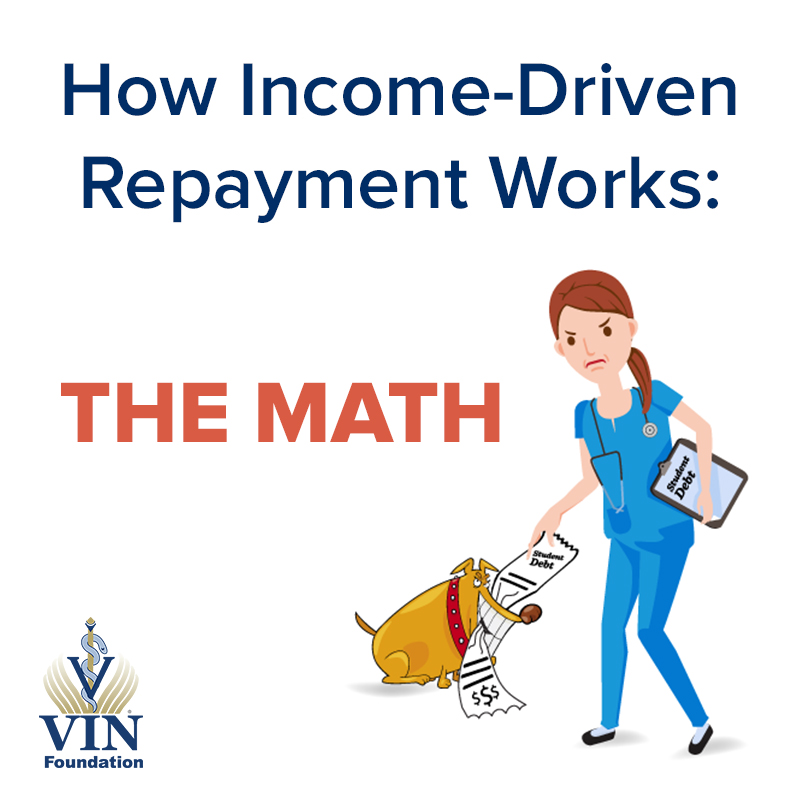“I was looking at the income-driven repayment plans, and the Pay As You Earn (PAYE) option seems like it will cost me the least amount of money. However, everything I read online says that the income-driven repayment plans cost you more money because although they lower your monthly payment, you ultimately pay more interest in the long run. I was wondering if you could break this down for me? I don’t understand how it will cost me the least amount of money if I never hit the principal balance and pay more interest?”
This question, asked by a 2019 veterinary graduate who attended the recent new graduate webinar we presented on student debt, is one of the most confounding aspects of income-driven repayment (IDR). Unfortunately, this confusion often prevents veterinarians from accepting the student loan repayment relief and other benefits provided by an income-driven repayment strategy.
We covered how income-driven repayment (IDR) works and broke down the conceptual aspect of this question in How Income-Driven Repayment Works post. Now we’re going to put those concepts into practice.
Here is the student loan “history and signalment” for this 2019 veterinary graduate:
- current federal student loan principal balance: $262,570
- unpaid interest balance: $35,494
- weighted average student loan interest rate: 6.34%
- current/anticipated repayment plan: not sure, maybe income-driven (PAYE)?? but loans not in repayment yet
- current/anticipated minimum monthly payment amount and any amount you’re planning to pay above that: not sure?
- any health profession student loan or loans for disadvantaged students: no
- any private loan balances and interest rates:
- Sallie Mae private student loan: $1,900 with interest rate 10.625%
- Sallie Mae private student loan: $1,886 with interest rate of 9.000%
- any credit card debt balances: $2,600
- current/anticipated taxable income (and spouse’s): $90,000 (no spousal income)
- family size: 1 (just me)
- marital and filing status: single
- spouse loan balance: none
Chief complaint/repayment goals:
“Pay off my loans the smartest way possible. I want to save the most money I can every month, but I also don’t want to be paying more in interest. I want to be able to save and invest in my future.”
Similar to our veterinary patients, in order to develop a sound treatment plan, we must first do a good “physical exam” of your student loans. Start by obtaining your NSLDS file and uploading it to the VIN Foundation My Student Loans tool.
After doing that for our 2019 veterinary graduate, we found $254,782 of Direct Loan principal at a weighted average interest rate of 6.34% with $34,770 of unpaid interest as of 06/30/2019. Her Direct Unsubsidized loans were in their grace period as of 07/01/2019, which makes them eligible for a Direct Consolidation loan.
There was also $7,788 of FFEL principal at a weighted average interest rate of 5.86% that was previously in repayment prior to our new graduated starting veterinary school.
Her Direct Loans qualify for PAYE, REPAYE, and IBR 2009. Her FFELs only qualify for IBR 2009.
Like we covered in the recent new veterinary graduate webinar, she can get 100% of her student loan balance to qualify for PAYE if she consolidates her loans using a Federal Direct Consolidation Loan. Doing so will help end her grace period early for her vet school loans, get the clock ticking towards forgiveness, help her include her FFELs to get them into PAYE and on the same clock as her veterinary school loans, and if she hasn’t started her job yet, secure a $0/mo payment for the first 12 months using PAYE.
With an estimated starting repayment balance of about $300,028, she will have a weighted average interest rate of 6.375%, reducing down to 6.125% with autopay after the consolidation.
Sending this information to the VIN Foundation Student Loan Repayment Simulator results in this projection:
If we enter her starting income, apply an estimated income increase per year, we see a total repayment cost of about $324,658 using PAYE. To achieve that, we assume she makes the minimum monthly payments required by her income, a 35% tax rate on the amounts forgiven, and estimate a 3% return on her forgiveness savings plan.
In this case, paying the minimum determined by her income and family size results in her total loan balance growing from $300,028 to $460,815. All of her payments went towards interest. With her minimum PAYE payments never covering her monthly interest accrual, she ends with a higher total balance than she started repaying.
This illustrates that while you only pay interest, you don’t pay more in interest. It’s a small distinction but a financially important one.
Once you reach forgiveness, we discount the remainder by an estimated tax rate to to complete the income-driven repayment strategy. By saving for the anticipated tax amount along the way and earning a return on those savings, we can further reduce the total repayment costs, as illustrated in the Forgiveness Planning Module of the simulation.
Watching the loan balance grow during repayment is one of the most difficult side-effects of income-driven repayment.
That often leads many borrowers to pay more than the minimum required by their income.
Let’s test to see what that does in this case:
Rather than paying the minimum determined by her income ($590/mo), we will assume she pays the monthly interest that accrues, $1,533/mo for 240 months. In that scenario, she would pay $367,920 in monthly loan payments and have $300,028 forgiven.
At an estimated 35% tax, she would need $105,000 on hand to cover that 20 years after starting repayment. To cover the tax, she would need to save about $319/mo for 20 years into an account(s) yielding 3% per year. In this extra payment test scenario, the total repayment cost would be $444,487.
Compare that to the $324,658 total in the simulation by paying the minimum and planning for the tax due on forgiveness. Yes, more is forgiven when you pay the minimum, but that is where the bulk of the discount resides.
In the additional payment example, the monthly total to cover your student loans is $1,852/mo ($1,553+$319). If you pay the minimum and plan for the forgiveness, your monthly total is $1,080/mo ($590+$490) in the first year of repayment.
She will have $772/mo more available to work with to meet other areas of her financial goals and invest in her future — the equivalent of a $9,000 raise for the year!
In the short term, she could be using some of those savings to pay down her credit card balance and private student loan balances. She can also work on building an emergency fund so she doesn’t have to carry a credit card balance in the future.
Moral of the story:
If you anticipate hitting student loan forgiveness under an income-driven repayment plan, you will save the most money paying the minimum and planning for the tax on your canceled balance. This will also maximize your monthly cash flow to help you meet other short and long-term financial goals.
If this analysis leaves you with more questions, please reach out. We’re here to help!

Tony Bartels, DVM, MBA
Dr. Tony Bartels graduated in 2012 from the Colorado State University combined MBA/DVM program and is an employee of the Veterinary Information Network (VIN) and a VIN Foundation Board member. He and his wife have more than $400,000 in veterinary-school debt that they manage using federal income-driven repayment plans. By necessity (and now obsession), his professional activities include researching and speaking on veterinary-student debt, providing guidance to colleagues on loan-repayment strategies and contributing to VIN Foundation initiatives.

